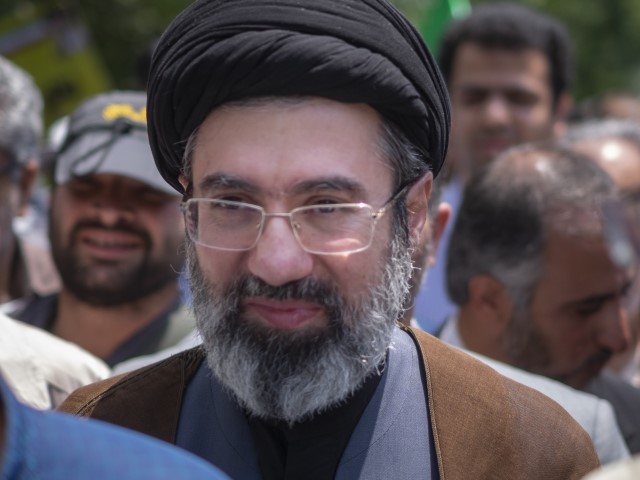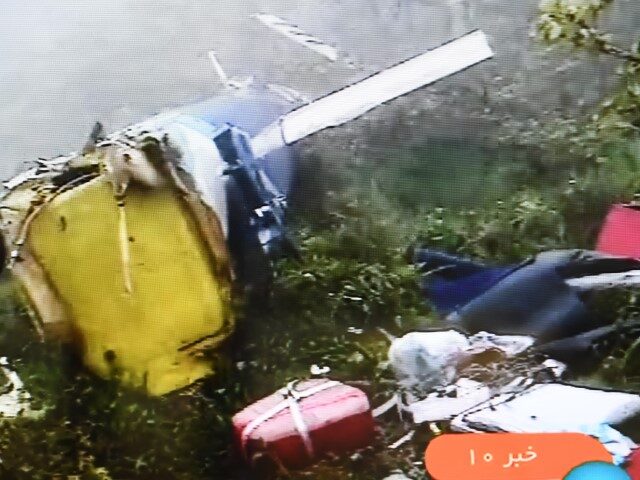The Iranian Armed Forces published a report on Thursday offering initial findings from the investigation into a helicopter crash on Sunday that killed the nation’s president, Ebrahim Raisi, and Foreign Minister Hossein Amir-Abdollahian.
Raisi, Amir-Abdollahian, and six others died on Sunday in the crash after departing nearby Azerbaijan to return home following an event to inaugurate a joint infrastructure project with Baku. While Raisi was second to “supreme leader” Ayatollah Ali Khamenei in the Iranian regime power structure, his sudden absence has left a massive void in Iranian politics, as many experts also believed him to be a potential candidate to be the next “supreme leader.”
The report did not offer any explanation for why the helicopter crashed, stating only that the aircraft hit “mountainous terrain” and investigators did not find any evidence of bullet holes, explosives, or other signs of sabotage.
The Iranian military also claimed that it had reviewed communications between the aircraft and the outside world from the beginning of the flight through the crash and that no “suspicious” content was found. The last communication between the helicopter pilot and the outside world, a message to the two other helicopters flying alongside it, occurred 90 seconds before the crash and did not indicate any distress on the aircraft, the armed forces report stated.
The Iranian government has avoided blaming its longstanding political enemies, America and Israel, for the helicopter crash, a marked contrast from Tehran’s reactions to the sudden deaths of other prominent regime members. In the absence of clear explanations for the crash, many Iranians have begun to speculate that Raisi was the target of an assassination plot, potentially by Khamenei’s son, Mojtaba, also identified as a potential successor to his father.

May 31, 2019, file photo shows the son of Iran’s Supreme Leader Ayatollah Ali Khamenei, Mojtaba Khamenei, attending a demonstration to mark Jerusalem day in Tehran. (Morteza Nikoubazl/NurPhoto via Getty)
The Iranian Armed Forces report on the helicopter crash encouraged Iranians to disregard conspiracy theories or any information not given to them directly by the regime.
According to the Islamic Republic News Agency (IRNA), a state news outlet, the General Staff of the Iranian Armed Forces claimed they had already completed “a remarkable part” of the information-gathering phase of the investigation.
“The helicopter carrying the senior officials crashed while flying along its pre-planned route, the report said, noting that the aircraft did not deviate from the course,” IRNA relayed. “The helicopter caught fire after crashing into a mountainous area, the report said, and revealed that the remainder of the wreckage did not bear any bullet holes or signs of similar impact.”
Iran International, an anti-regime news organization, noted that the Armed Forces statement did not offer any clarity on the possibility of a mechanical error or the pilot accidentally or intentionally crashing the plane.
Another revelation in the initial report that left unanswered questions is the confirmation that authorities found the helicopter at 5:00 a.m. local time on Monday, leaving the passengers unattended for hours. The Armed Forces blamed “fog and low temperature” for delaying search and rescue operations. The weather situation surrounding the crash has been among the more controversial aspects of the investigation, as helicopters are notoriously vulnerable in foggy situations. The exact status of the weather when Raisi’s helicopter took flight has been a topic of debate.
“A senior government official blamed inclement weather for the crash. But another senior official claimed that there were no abnormal weather conditions,” the Japanese news outlet NHK World reported on Friday, relaying the findings of the Armed Forces report.
Gholamhossein Esmaili, Raisi’s chief of staff, was on one of the other two helicopters that survived the return from Azerbaijan, according to IRNA, Esmaili described the weather on that day as “perfect.” Yet Iranian authorities claim search and rescue operations were delayed in part by the weather.
Esmaili was one of several witnesses who testified that Iranian authorities had received signs of life from the helicopter shortly after the crash. IRNA reported that officials contacted the helicopter after it appeared to disappear from radar and, rather than reaching the pilot, were able to speak to Mohammad Ali Ale-Hashem, a cleric who was in the president’s entourage. Ale-Hashem reportedly said the helicopter “crashed into a valley.”
“Esmaili himself made a second contact with Ale-Hashem and received the same answers about the situation,” IRNA reported.
“When we found the location of the accident, the conditions of the bodies indicated that Ayatollah Raisi and other companions had died instantly but Ale-Hashem had been martyred after several hours,” Esmaili reportedly said.
On Sunday, prior to the confirmation of Raisi’s death, IRNA reported that the incident with the helicopter, which had been reported as a “hard landing,” had “not been rough,” citing communications with people still alive in the helicopter as proof. Less than 24 hours later, IRNA would report that all onboard had died.
The Iranian regime buried Raisi on Friday after three days of funerary rites featuring special guest terrorist leaders and chants of “Death to America!” and “Death to Israel!”

COMMENTS
Please let us know if you're having issues with commenting.